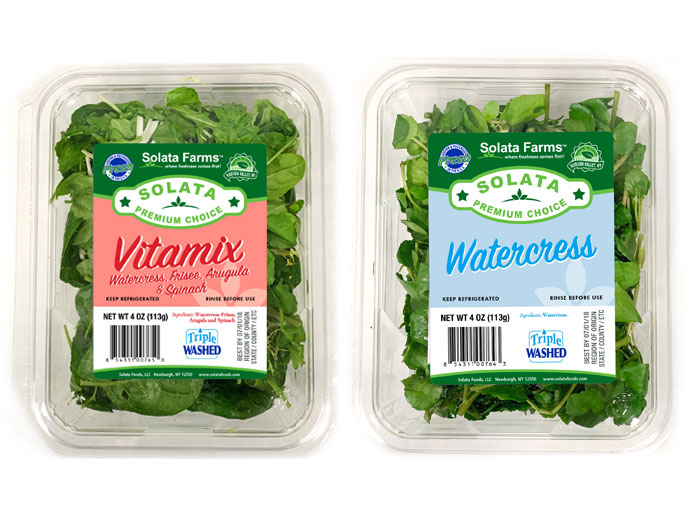Newest Variety of Watercress Makes its U.S. Debut
November 4, 2019 | 5 min to read

NEW YORK CITY — You might think a dark, leafy vegetable that is scientifically proven to do everything from fight cancer to combat the effects of aging would be #1 on everybody’s grocery list. But watercress has long been the overlooked miracle green in U.S. grocery aisles.
Now two iconic produce specialist firms are bidding to change all that.
The Watercress Company (www.watercress.co.uk), based in Dorchester, Dorset UK, and Solata Foods (www.solatafoods.com), based in Newburgh, NY, are teaming up to launch an aggressive campaign promoting this healthful superfood.
The Watercress Company is a progressive and enthusiastic grower that produces the finest quality products in a safe and sustainable way across their farms in the UK, Spain and Florida.
“We are finally giving watercress the star treatment it deserves,” declared Tom Amery, Managing Company Director. “Beginning immediately, The Watercress Company and Solata will showcase watercress as the hot new premium salad, because it’s by far the healthiest thing you can put in your body.”
Amery added: “Launching our Watercress with Solata Foods is a fantastic opportunity as it’s new, exciting and not available in the market. The version we are selling is called Nasturtium and this is the original type that dates back to the ancient Romans and has some incredible properties only found in this version of watercress.
“The peppery taste is totally unique and will be a huge success in the mixes but also in the solo form as its great in salads, sides, pestos or smoothies,” Amery said. “We have many years of experience and understand the strong relationship watercress has with its consumers – they will keep on coming back for more.”
Premium Packaging containing flavors to match
The Watercress Company and Solata Foods will be producing varied combinations of value added salad blends featuring watercress as the key ingredient. Packaging configurations will include a retail clamshell package as well as a bulk size for food service.
Mixes featuring watercress include Nutri-mix, watercress with super greens such as beet tops, chards, and spinach; Britaly, a play on bringing Italian tricolor salad (Frisee, Radicchio and arugula) and swapping the arugula for British-grown watercress; Vita-mix, a combination of arugula, spinach, frisee and watercress; and Hot and Sweet, a blend of baby sweet lettuces and the spiciness of watercress.
Solata’s CEO Roger Zlotoff stated, “For too long, watercress has been treated by American buyers as a cooking ingredient, rather than a salad ingredient. The U.S. market is overdue to upgrade watercress beyond its current status.”
Zlotoff added: “Asians and Europeans have understood the health benefits of watercress for more than 2,000 years. In the UK, watercress has been a major staple for the last 125 years. The reason is simple. Watercress truly is one of the most amazing foods on the planet.”
Astonishing health benefits
The list of scientifically documented health benefits from watercress is nothing short of amazing.
What’s more, that list has been growing steadily since at least the 1980s.
Back then, nutrition experts touted watercress as offering, ounce for ounce, “more calcium than whole milk, more vitamin C than oranges, more iron than spinach, more folate than bananas, and more B vitamins than black currants.”
Yet even nutritionists who promoted watercress were surprised in 1995 when University of Minnesota researchers documented the vegetable as one of nature’s richest sources of PEITC (phenylethyl isothiocyanate), which helps fight cancer. UM lab studies showed PEITC helped neutralize certain carcinogens and helped subjects resist cancers developing.
Over the next dozen years, a series of follow-up studies in prestigious science journals in both the U.S.[1] and the UK[2] indicated that eating watercress:
- Reduces cellular DNA damage (which can lead to cancer) by nearly 25%
- Limits the ability of cancer cells to metastasize (spread)
- Blocks certain bio conditions needed for breast cancer tumors to grow
- Reduces skin damage
- Makes breast cancer cells more vulnerable to radiotherapy and protects healthy cells from radiation treatment
- Increase the Elasticity in the blood vessels helping reduce blood pressure
- Improves blood flow and enhances athletic performance
- Virtually eliminates damage otherwise caused by free radicals during highly intensive exercise
- Can even reduce facial wrinkles up to 49%
Additional studies have
indicated that eating watercress helps lower glucose levels and increase
insulin sensitivity in diabetic patients, improves thyroid gland function,
boosts cardio health and bone health, reduces the risk of depression, helps
prevent stroke, aids in fetal development and pregnancy, helps prevent
cognitive disorders, improves eyesight and brain health, and even helps avoid catching
the common cold.[3]
[1] Gill, Haldar, Boyd, et al: “Watercress supplementation in diet reduces lymphocyte DNA damage and alters blood antioxidant status in healthy adults,” The American Journal of Clinical Nutrition, Volume 85, Issue 2, February 2007, Pages 504–510, https://doi.org/10.1093/ajcn/85.2.504. Also: https://cebp.aacrjournals.org/content/4/8/877.short; Breast Cancer: https://www.sciencedirect.com/science/article/abs/pii/S0006295209002949; Lymphocyte DNA damage: https://academic.oup.com/ajcn/article/85/2/504/4649753; Sports DNA damage: https://academic.oup.com/ajcn/article/85/2/504/4649753
[2] Steve Rothwell, “Don’t Forget Watercress,” Produce Business, June 1, 2018; https://www.producebusiness.com/dont-forget-watercress/
[3] Meenakshi Nagdeve, “17 Impressive Watercress Benefits,” Oct. 4, 2019; OrganicFacts.net; https://www.organicfacts.net/health-benefits/vegetable/watercress.html
